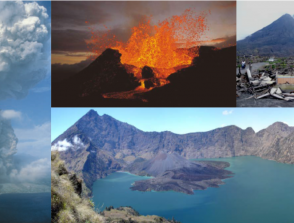Assessing rock strength distribution in lava dome with 3-D muon tomography and implications for partial edifice collapse hazards
Start: 01 October 2020
End: 06 June 2023
Supervisors :
Marina Rosas-Carbajal, Alessandra Tonazzo
Related teams :
Volcanic Systems
Status: Defended
Partial collapse of volcanic edifices is a major hazard associated with active and
extinct volcanoes. These destructive movements of rocks, debris, or earth down a slope
can be responsible for the loss of thousands of lives and huge economic damages. In the
case of volcanoes, partial edifice collapse may be triggered by large eruptions (e.g. Mount
St. Helens, USA, in 1980) and cause the emplacement of large debris-avalanches that can
be tsunamigenic depending on the context. But they can also have an external trigger
such as a large earthquake (Ontake volcano, 1984, Japan) or even heavy rain episodes
(e.g. Casita volcano, 1998, Nicaragua).
Volcanic hydrothermal systems are key players influencing the proneness of a
volcanic edifice to collapse. Fluid and pore-pressure re-distributions in these systems may
be sufficient to trigger the collapse. Fast alteration of the edifice given the circulation of
these hot and extremely acid fluids results in mechanically weak rock that is more
vulnerable and unstable.
The stability of volcanic edifices has been thoroughly studied since the dramatic
Mount St Helens flank collapse in 1980, but is often hard to assess correctly due to the
lack of data on their internal structure and rock properties (Voight, 2020). Imaging the rock
composition of volcanic edifices, their degree of alteration, and fluid distribution, is key to
improve the assessment of this natural hazard and therefore to mitigate its disastrous
effects. To do so, non-invasive geophysical methods can be used. In particular, knowledge
of the density distribution in the upper volcano structure (lava dome) can help to determine
mechanically weak regions that may result in flank collapse.
Volcano density structures are traditionally studied with gravity data, and 3-D
models solely based on these data are highly non-unique and low resolution, especially
since field conditions often make it difficult to achieve a good data coverage. Muon
tomography has emerged in the field of geophysics in recent decades (Bonechi, 2020),
allowing to estimate the distribution of mass density in a geological body by measuring the
flux of muons that traverse it. The method is similar to X-ray radiography, where the
particles are absorbed according to the mass density distribution along the traveled path
(Procureur, 2018). Muon tomography involves performing a radiography of a
geological body of large dimensions by using a single detector. The application of muon
tomography to specific problems has fostered rapid progress in terms of instrumentation,
the theory behind the application, and the methodology used for data analysis (Kaiser,
2018). However, this method is still novel in many aspects, with numerous possibilities for
improvement in terms of optimizing spatial resolution, reducing the data uncertainty, and
combining it with other geophysical methods (Bonomi et al., 2020).





